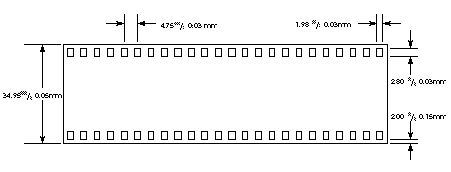
We'll start with a portion of the specification for 35mm film. Each of the sprocket holes is called a "perforation", or "perf" for short. All dimensions are in millimeters.



This drawing shows two frames of European format. Because each image takes up 7 perforations on the film, European format is called a "7-Perf" format. The thing to note here is that the frames alternate. Imagine the film advancing through the camera. First you take picture stereo #1 (consiting of both 1Left and 1Right). Now you advance the film 7 perforations and take stereo picture #2. Now before you can take stereo picture #3, you must advance the film 21 perforations to get to a blank spot on the film. This ratio of every other advance being 1 frame (7 perforations) and then three frames (21 perforations) give the European a 1-3-1-3-1-3 advance sequence, and of course complicates the advance mechanisms of European format cameras.

The Realist format images take up 5 film perforations. This, together with the spacing between the lenses, gives two frames between each stereo pair. Here the advance sequence goes like this: First take stereo pair #1. Then the camera advances the film two frames (10 perforations), and photo #2 is taken. The camera again advances 2 frames, and photo #3 is taken (part of which is not show - the "left" side of photo #3 would be off to the left of this drawing). This method of film advancing is simpler than the European 1-3-1-3 sequencing, as the film advance distance is always the same.

The 3D Image Technology family of cameras takes three consecutive half-frame images (4 Perf). Since there is no interleaving of images, the camera need merely advance 3 frames (12 perf) each time a photo is taken.

The Nimslo/Nishika format is similar to the 3D Image Technology format, but takes four half-frame images (4 Perf each). In this case, of course, the camera must advance 4 frames (16 perf) each time.
Note: an alert reader has pointed out that these two cameras have a 1-perf space between each set of four images, and thus advance 17 perfs each time. A new drawing is in the works...

Since a beamsplitter is just an attachment for a normal 35m camera, it follows that the on-film images take up one normal 35mm (8 perf) frame. Each frame is split in two vertically, and half-frame images appear on each 35mm frame.
(under construction)
(under construction)